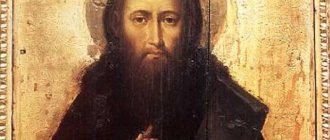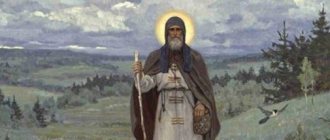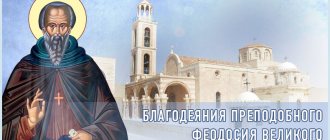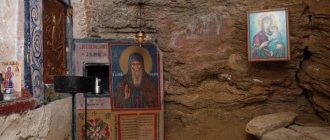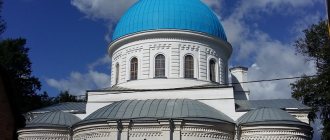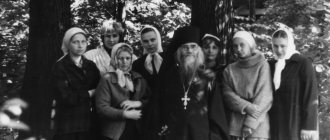Theodosius of Pechersk is the first reverend of the Russian Orthodox Church, “the father of Russian monasticism.” This saint, who lived in the 11th century, is known as a church and political figure, author of literary works, and founder of the Kiev Pechersk Monastery. Theodosius was canonized in 1108. Nestor the Chronicler, who dedicated an extensive work to the Reverend, dealt with the description of his life path. The text has a historical basis, represented by legends, traditions, and oral stories of monks.
Brief description of the work
“The Life of Theodosius of Pechersk” is the brightest example of ancient Russian literature. The work has an incompletely clarified history of creation. The date of its writing is the year 1080 or the beginning of the 12th century. The work belongs to the outstanding literary monuments of Kievan Rus and the Muscovite Kingdom. The work of Nestor, who was a monk of the Kiev Pechersk Monastery, describes different stages of the Saint’s life - from birth to death.
The Life consists of two voluminous parts. The first is dedicated to the Reverend’s childhood and youth, to his difficult relationship with his own mother. The content of the second is his biography and the history of the formation of the Pechersk Monastery.
The life begins with an introduction in which the author asks the Lord to help him write. The main narrative is divided into a number of smaller stories focusing on the central character. Each of the written sections eloquently illustrates the holiness and spiritual perfection of the main character.
If you want to read the life itself, you can do this, for example, on the website https://lib.pushkinskijdom.ru/Default.aspx?tabid=4872.
What is the story about?
The date of birth of Theodosius of Pechersk is 1008. The main character of the life was born in the city of Vasilkov (formerly Vasilev), located near Kiev. The future saint was brought up in a noble family, but did not strive for luxury and most of all gravitated towards God.
Childhood and youth
The work, created in the hagiographical genre, reports: from an early age, Theodosius was unlike his peers. He often attended church, wore modest clothes, and avoided children's games and amusements. The boy mastered reading and writing early and amazed everyone with his unusually wise sayings.
When Feodosius was 13 years old, his family moved to live in Kursk. Soon the boy's father died. After this, the youth began to devote even more time to reading Divine Scripture and attending church services.
It is known that Theodosius’s mother did not want to see him among the worshipers. The woman punished her son for his religious actions - trying to go to Jerusalem, wearing chains (an iron belt and other devices to pacify the flesh). Instead of being angry, the young man patiently accepted this, thanked God for the trials he had sent and sincerely prayed for his mother.
Took monastic vows
One day, Theodosius decided to secretly leave his home and go to Kyiv. Inspired by stories about St. Anthony, he dreamed of meeting him. Arriving in a cave to an old man who had renounced the world, Theodosius began tearfully asking to be accepted into monasticism. Anthony blessed the young man and gave him into the care of Blessed Nikon. Soon this priest tonsured 23-year-old Theodosius a monk.
In subsequent years, Theodosius served God with deep faith and followed all the instructions of Elder Anthony. Without sparing himself, he prayed at night and engaged in hard physical labor during the day. The young monk strictly observed the fasts and aroused great respect for his faithful service to the Lord. For his righteous life, St. Anthony and Blessed Nikon tirelessly glorified God.
Mother Theodosius searched for him for a long time. Having met her son in the Pechersk monastery, she began to ask to return home. Soon the woman herself took monastic vows in one of the nunneries, where she remained until the end of her days.
Abbess and foundation of the Kiev-Pechersk Monastery
In 1057, the Monk Anthony called Theodosius to himself and blessed him to become abbot of the Pechersk Monastery, where 12 brothers lived. In subsequent years, a wooden building of the monastery was erected and its original charter was adopted. Theodosius also initiated the construction of a church in honor of the Dormition of the Virgin Mary.
The times of the Monk's abbess fell on a difficult and troubled period. Princes Svyatoslav of Chernigov and Vsevolod of Pereyaslavsky removed their elder brother Izyaslav of Kyiv from power. One day they invited the monk to dinner, but the abbot flatly refused. Subsequently, he openly exposed them in the illegal appropriation of the brotherly throne.
Theodosius taught the monks every day to true repentance. He was not afraid of hard work, wore a stiff hair shirt and ate modest food. The monk sincerely rejoiced and praised God when his disciples read prayers, and was deeply upset because of their mistakes. During the life of the Saint, the Pechersk Monastery truly flourished, and it was often compared to a heavenly monastery.
Theodosius' rare humility surprised everyone around him. He taught the brethren not to be arrogant, to avoid direct condemnation of their neighbors, to place themselves lower than others, and supported everything he said by personal example.
The life of the Reverend was filled with compassion for his neighbors. Theodosius helped the poor, the needy and the sick. He settled all those in need at the monastery and gave a tenth of the monastery income to support them. On Saturdays, the abbot sent bread to prisoners in dungeons and prisons. He instructed the robbers in every possible way to perform righteous deeds.
Death of St. Theodosius
The author of the text says that, being a saint, Theodosius knew in advance the day of his own death. On May 16 (May 3, old style), 1074, the Reverend left this world and went to the Lord. The abbot was buried in a cave, which he dug on his own during his lifetime to be alone with God. In 1091, his relics, which had become incorruptible, were received by the Assumption Cathedral.
Biography of Theodosius of Pechersk
The detailed biography of the saint, written by Nestor the Chronicler, fully corresponds to the composition of his life, including all milestones, from birth to death. Next, we will briefly get acquainted with the key moments in the life of the reverend.
Theodosius of Pechersk – father of Russian Orthodoxy
Boyhood
Theodosius came from the city of Vasilevo in 1008 from the birth of Christ. When he turned 13 years old, the family was forced to move to Kursk, where the boy began his path to holiness. From an early age he showed humility and asceticism, setting himself the goal of serving God. However, the parents were categorically against such a decision by their son. One day the young man ran away, joining the pilgrims going to the Holy Land. Then the mother caught up with the fugitive, beat him, and then forbade him to leave the house.
Soon a second escape took place. Theodosius left home, settling with a clergyman from a neighboring city. However, this time the mother returned home. Then the young man ordered an iron belt from a blacksmith, which he wore, rubbing his skin until it bled. Seeing the bloody stains on the clothes, the parent became angry and again severely punished her son.
Took monastic vows
Finally, Theodosius managed to finally leave the city. He moved to Kyiv, where he turned to Anthony of Pechersk, begging him for tonsure. So, around the 30s of the 11th century, the future saint became a monk of the Kiev Pechersk Lavra monastery.
Soon Theodosius accepted the priesthood, continuing his ascetic labors:
- prayed tirelessly at night;
- did someone else's work;
- Having climbed the mountain, he exposed himself to the waist and allowed himself to be bitten by insects, praying incessantly.
Abbess
In 1054 the monk became abbot. He did not give up his usual life, continuing to profess humility. Together with his brothers, the abbot did all the work around the monastery, wore a hair shirt under simple clothes, and communicated with everyone on an equal basis.
In 1054, Theodosius of Pechersk became abbot
The author of the life of Theodosius of Pechersk gives several examples characterizing the personality of the abbot:
- Every night the monk walked around the cells. If he saw that one of the monks was engaged in empty talk instead of prayer, he became upset, and the next day he denounced them through parables.
- Together with the bakers, the saint personally kneaded the dough and baked bread.
- When the monastery ran out of wood or water, and no one wanted to replenish the supplies, the abbot himself went to the well or cut wood.
During his abbotship, Reverend Theodosius played a huge role for the Russian Orthodox Church. He was the first to found a cenobitic monastery. Having asked the Kyiv prince for a plot of land, he built cells there where the monks moved, and later erected the Church of the Assumption of the Virgin Mary.
The saint introduced the Studio Charter in the Pechersk Lavra, which the Russian Orthodox Church later adopted as its basis.
Relations with the princely nobility
During his abbotship, Theodosius of Pechersk witnessed the reign of two Kyiv princes. The saint had a trusting relationship with Izyaslav, he even became his spiritual father. Nestor the Chronicler mentions a couple of stories about this:
- One day the prince came to the abbot to share a meal with him. He was surprised how tasty the food was. Expressing his bewilderment, he heard: “This is because in the monastery everything is done with a blessing.”
- From the monk Izyaslav learned humility and meekness. When the gates of the monastery were closed in the afternoon, he always patiently waited for Theodosius to arrive in order to talk with him.
But the relationship with Svyatoslav did not work out for the abbot of the monastery. He was against the usurper’s seizure of power, and therefore, without fear, he denounced the prince for his illegal acts. Once the ruler of Kyiv even wanted to arrest the saint, but over time he warmed to the saint and began to venerate him.
The saint introduced the Studio Charter in the Pechersk Lavra
Death and subsequent canonization
The monk foresaw his death and a few days before his death he gathered the entire monastery brethren around him. They prayed together, the abbot gave instructions, blessed, and on May 3, 1074, he left this world. Theodosius was buried on the banks of the Dnieper, in one of the stone caves from where his path to holiness began.
After 15 years, it was decided to transfer the remains to the Church of the Assumption of the Blessed Virgin Mary. When the monks opened the grave, they discovered that the relics remained incorrupt. The former rector was canonized only 34 years later.
Miracles of the Saint
The Monk Theodosius was famous for many miracles during his lifetime:
- when the brethren ran out of supplies or there was a bad year, after his prayers people appeared who wanted to help and brought the necessary provisions to the monastery;
- Robbers repeatedly tried to attack the monastery for the purpose of robbery, but they saw the building soaring into the air and retreated away in horror;
- Passers-by more than once observed how the Monk Theodosius stood near the church and prayed, while an incredible light spread around.
Nestor mentions an interesting story from residents whose houses were located near the monastery. One night, people were awakened by a chorus of voices coming from the monastery. Having gone out to find out what was happening, they saw a procession with an icon of the Most Holy Theotokos. It was headed by Theodosius, and behind him there were many, as it seemed to eyewitnesses, monks. Having finished the procession, they all prayed together, then returned to the church singing.
As it turned out later, the residents of the monastery did not participate in the events described. Then it became clear that people saw the Reverend together with the praying angels.
Features of the work
The literary work of Nestor the Chronicler is distinguished by the following artistic merits:
- a large number of realistic details;
- psychologism of characters;
- believable remarks and conversations;
- variety of stylistic means.
- bright symbolism and metaphor.
Lexical analysis of the work reveals a lot of interesting things in it. The text organically intertwines 2 main languages - Old Church Slavonic and Russian (elements of the second make up a smaller share). To some extent, the text contains foreign words. Other linguistic features of life are:
- a combination of vocabulary of different styles (church terms alternate everywhere with everyday expressions);
- complex declension of adjectives and participles;
- the predominance of simple syntactic structures over complex ones;
- an abundance of biblical quotes and prayer texts.
Due to its theological depth and patriotic pathos, “The Life of Theodosius of Pechersk” gained enormous popularity. The narrative was included in the Kiev-Pechersk Patericon, and was also placed in separate collections.
Being a monument of ancient Russian writing, the life became a model for many authors in subsequent eras. Thanks to Nestor’s innovation, the tradition of creating other hagiographic works began to actively develop, describing in a fascinating form the deeds of Orthodox saints.
Creations
| St. Theodosius Pechersky |
Rev.
Theodosius left five teachings to the Pechersk monks in full (the first and second - about patience and love, the third - about patience and alms, the fourth - about humility, the fifth - about going to church and prayer), one to the cellarer, four fragments of teachings to monks and laity, two teachings to the people “about the executions of God” and “troparary cups”, two messages to Vel. to Prince Izyaslav [“about the peasant and Latin faith” and “the slaughter of animals on Sunday (week) and about fasting on Wednesday and Friday”] and two prayers (one - “for all Christians”, the other - written at the request of the Varangian prince Shimon, the so-called prayer of permission). From the teachings to the monks, we learn the dark sides of the monastic life of that time, which neither Nestor the Chronicler nor the Pechersk Patericon, who were exclusively concerned with glorifying the famous monastery, speak about. Theodosius denounces the monks for laziness in worship, non-compliance with the rules of abstinence, collecting property in the cell, dissatisfaction with common clothing and food, grumbling against the abbot for supporting the strange and poor with monastic funds.
Two teachings of St. Theodosius addressed to the whole people: one “about the executions of God” for sins, a remarkable depiction of the remnants of pagan beliefs among the people and the prevailing vices of the time, robbery, self-interest, bribery and drunkenness; the other is directed against drunkenness.
Two messages to Grand Duke Izyaslav answer modern questions: the issue of fasting on Wednesday and Friday is resolved in accordance with the Studio Charter; in the message about the Varangian or Latin faith, deviations from Orthodoxy and the customs of the Latins are calculated, all communication with them in food, drink and marriage is prohibited.
In historical terms, the teachings of St. Theodosius are of great importance for characterizing the morals of that time. The literary works of Theodosius of Pechersk became famous not very long ago; the authenticity of some of his teachings is subject to strong doubt; for example, the latest scientific research considers two teachings - “about the executions of God” and “about troparary cups” - not belonging to St. Feodosia.
